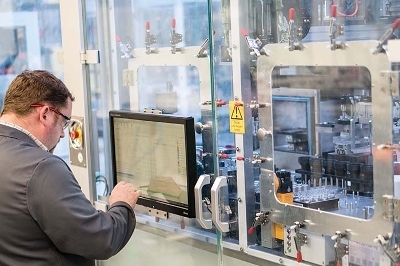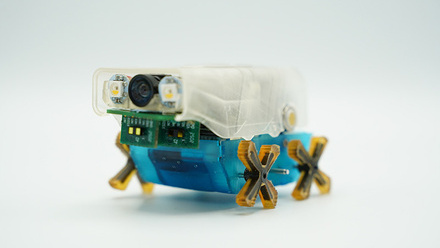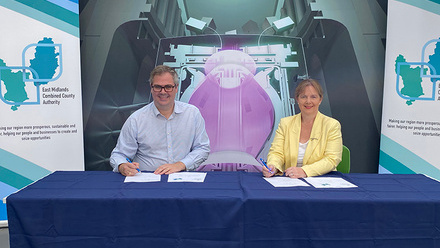Behind the scenes at the Materials innovation Factory
Digital tools are shortening the process time for materials innovation and discovery. Matt Reed of the University of Liverpool’s Materials Innovation Factory, shares some current projects.

The industrial digital technologies that are driving Industry 4.0 – big data, digital twinning, automation, robotics and artificial intelligence (AI) – are also driving a transformation in research, innovation and product development in advanced materials, chemistry and formulation.
At the Materials Innovation Factory (MIF) in Liverpool, UK, we have recently developed a process for applying leading digital tools to the innovation process. The factory’s aim so far is to transform the scale, pace, quality and impact of translational research, by applying the digital technologies of Industry 4.0 to traditional materials science R&D creating Innovation 4.0. This approach is already shortening the journey to academic discovery. It allows companies to re-engineer and de-risk their innovation process, so they can launch innovations of a larger scale into the market faster.
The MIF, an £81mln state-of-the-art facility located at the University of Liverpool campus, was founded as a strategic partnership between the University, Unilever and UK Research and Innovation (UKRI), as an international centre for advanced materials excellence and expertise.
The 12,000m² site is open by design, meaning the labs, highly skilled staff and advanced scientific equipment are available for use by both academics and industry specialists alike. Onsite, a dedicated team of technical experts assist with experiments and train scientists on how to use open-access resources and equipment. It also houses Royce@Liverpool, a contribution to the £235mln Henry Royce Institute, bringing together the University of Liverpool with eight research organisations across the UK to create a national centre for advanced materials.
Here come the cobots
One area of focus is changing the way that highly functional materials are designed at the atomic scale by fusing chemical knowledge, computer science, lab automation and digital R&D. We work with companies large and small, from big corporates to micro SMEs, to create leading-edge digital tools for their innovation processes across the areas of advanced materials, chemistry and formulations.

A core technology used in Innovation 4.0 is the Internet of Things (IoT), to create digital lab benches that automatically capture everything a scientist does, without changing what they do, or how they do it. This allows lab scientists to produce detailed experimental datasets of what they do with an improved level of traceability, compared to manual recording in a notebook. This data is then automatically stored using cloud computing systems for more secure and effective data management.
Automated workflow systems and co-operative robots, known as cobots, are being used in our labs to perform long sequences of high frequency tasks that humans cannot execute with such high levels of reproducibility. Cobots reduce monotonous and repetitive work, and this partial automation provides scientists with more time to think creatively and comparatively about what the data is telling them and how to reach their next level of insight or discovery.
Machine learning and AI techniques are also harnessing algorithms to provide materials innovators and R&D teams with deeper insights. This information is then used to publish results in high-impact journals, file patents, create new software platforms, and design and improve future research programmes.
Digital twin approaches are being used to design, test, create and simulate virtual experiments before they are implemented in the real world for a fraction of the costs of traditional R&D. Applying these emerging areas of digital technology, in combination with highly sophisticated feedback control loops, has led to the first generation of Innovation 4.0 research labs.
Transparent conducting materials
At present, the MIF is home to over 200 academic researchers, including some of the world’s most decorated scientists such as Professors Andy Cooper and Matt Rosseinsky who are both Fellows of the Royal Society. The University of Liverpool’s Chemistry Department was also ranked as second in the UK for world-class research in the last Research Excellence Framework and has produced a continuous stream of seminal academic publications and industry collaborations.
A recent example is the MIF’s search for new transparent conducting materials, along with NSG Pilkington, originally a UK company now headquartered and owned by NSG in Japan, who manufacture glass and glazing solutions. A critical component of the business is developing functional glass coatings that serve high-value applications in markets such as automotive, architectural glass and displays. Working with the MIF and the UK Science and Technology Facilities Council’s (STFC) Hartree Centre, NSG Pilkington seeks new high-performance, transparent, conducting materials to underpin the next generation of their products.
The research project is supported by the UK’s Knowledge Centre for Materials Chemistry (KCMC) partnership and the EPSRC Impact Acceleration Account funding, with work by MIF academics Professor Matt Rosseinsky, Dr Matthew Dyer and Dr Chris Collins.
The project combines computational methods to explore structural and compositional space. The MC-EMMA computational code developed by the University of Liverpool team works with high-power supercomputing capabilities and expertise at the Hartree Centre to increase the scale of the search for transparent conducting materials.
The research team has discovered new materials for NSG using this approach that have properties relevant to LED lighting and energy generation and storage, and they are now developing a suite of codes integrated with experimental approaches for functional materials discovery. The KCMC’s Materials Innovation Translator funding programme has provided computational scientists to optimise and port the materials discovery code.
Building upon this success, the EPSRC Impact Accelerator Account funding provides the opportunity for a two-year secondment for Dr Andy Zeng from the University of Liverpool to work across the three project partners, and access to STFC facilities is provided via their Bridging for Innovators (B4I) scheme. Dr Zeng’s secondment has allowed the computational and digital methods to be successfully embedded into NSG Pilkington’s R&D culture and highlights the opportunity for digital approaches to tackle problems across the firm’s global operations.
The interaction within the project team also gave rise to further opportunities for improving the codes used. One PhD studentship addressing thin film deposition of the materials classes studied in the project has been subsequently funded. Currently under consideration is funding for a second PhD studentship to isolate the predicted new materials in bulk form.
Clearing the air

Designing porous, organic cages for the removal of formaldehyde has been a core area of study. According to the World Health Organisation (WHO), indoor air pollution causes an estimated 3.8 million deaths around the world every year. Formaldehyde, the most common indoor air pollutant, can be emitted from walls, floors, cabinets, furniture, fabrics and cigarette smoke, and has been classified as a Group 1 human carcinogen by WHO. Despite the health problems that it is believed to cause, current technology used to capture formaldehyde is not particularly effective due to issues around low-capture capacity and poor selectivity.
Recognising the importance of removing formaldehyde, an MIF research team, led by Professor Andy Cooper and Dr Ming Liu, has developed a molecular solution to this challenge – a ‘cage prison’. The team has designed and synthesised cage molecule solids that efficiently capture low-concentration pollutants, using a combination of chemical and physical adsorption. The cage material has been proven to very efficiently capture formaldehyde at both high and low concentrations, and in the presence of high humidity.
To demonstrate its potential as an effective air filtration material, the team has created a prototype air purifier fitted with cage-loaded air filters. They have also fabricated several cage-loaded air filters that have been independently tested.
In parallel, market validation analysis has been carried out to develop a commercial plan to prioritise applications. Working with commercial partners, the material synthesis has been scaled up to an industrial level cost-effectively to determine an accurate cost and identify key target market sectors, including chemical, automotive and healthcare industries.
Following £300,000 of Innovate UK funding, a new University of Liverpool spin-out company – CageCapture – will take forward the technology to reduce both household and environmental exposure.
The CageCapture technology is particularly effective in reducing exposure for individuals who have long durations of being housebound, lowering the chances of poor health and thereby increasing the likelihood of independent living later in life. In the longer term, this project will no doubt play an important role in improving air quality and raising awareness of the impact that indoor air pollution has on health across the UK.







